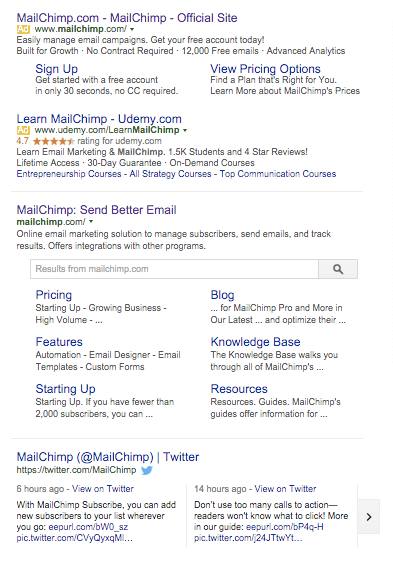Today’s online marketplace is a fiercely competitive arena in which businesses vie against each other to gain better placement in the search listings. This, of course, is not always the easiest thing in the world to achieve. The race to the top of Google is one that all of a business’s competitors will be partaking in, and each and every one will be involved in their own varied – but nonetheless similar – strategies to get there.
These strategies essentially come in two forms. The first is to use paid advertising, such as Google AdWords, to buy your way to the top (which isn’t always possible when pitting against large brands with huge budgets), and the second is to use search engine optimisation (SEO) in order to naturally rank high in organic search results.
Both of these methods can and do yield results. Indeed, search engine marketing (SEM) is extremely important in this day and age, and organisations all around the globe acknowledge this. If you browse the internet (using a search engine), you will find that there is a lot of content already in existence that pits organic and paid search against one another.
The question that the various articles are often trying to answer is – which is better?
However, a less-often explored avenue is how paid advertising can be used to drive organic traffic, and that is exactly what I want to discuss here.
Instead of separating these two prominent SEM methods and viewing them as strictly distinctive, some marketers focus their efforts on exploring ways and means that both organic and paid search can be used to complement each other. This can be the most effective approach to online marketing, and will certainly do wonders when trying to drive more traffic to your website.
Below we’ve put together the top 5 tips to help you get the most out of complementary approach and get your products and your site pages to the top of the SERPs.
5 Ways To Use Paid Advertising To Drive Organic Traffic
#1. Testing Copy
Good organic SEO practices no longer rely as heavily on keywords as they once did. Black hat SEO practices such as ‘keyword stuffing’ have meant that the search engines have had to find ways to penalise those sites that attempt to trick them. Now, keywords remain a major part of your strategy, but these can be used alongside contextual phrases and long tail keywords to better effect.
Keywords are still important for organic search, and, as it happens, they’re pretty darn crucial for paid search rankings as well. So – how can you combine the two?
Naturally, when running your paid campaigns, you will be testing the ad copy with various keywords and then running analytics to see which ones are generating more leads.
However, this is information which you can use on both sides of the fence. By testing the copy of paid advertisements, you will be able to see precisely at which point during searches users are finding your content enticing, useful or informational. You can then use this information to inform your organic copy – including the copy that you use on your landing pages and in social media.
#2. Cementing Consumer Trust
These days, people don’t just head online, type in the name of the item that they want to buy in the search engine, and then simply purchase the first thing that pops up in the SERP. Instead, they like to work a little research into their options. Now, whilst a paid advert may very well find its way more frequently at the top of SERPs in the ‘ads’ section, what helps seal the deal is having an organic placement within sight of the paid one. The reason is simple – the more frequently your brand and your web pages are seen by your users, the more they will begin to place trust in you and your products.
#3. Muscling Out The Competition
Whilst the screenshot was taken to illustrate the previous point, it also exemplifies this one. The more space that is taken up on search engine results pages by you, the less room there is for your competition.
This holds true across both paid placements and organic ones. If you’ve got a strong paid campaign complementing your organic one, then the amount of real estate that you will be taking up at the top, bottom, left and right sides of SERPs will leave little room for anything else. And the more eyes that are landing on the links to your site, the greater your brand awareness, and that will lead to much more traffic, both directly and indirectly.

#4. Keyword Optimisation
The keyword research that you will be conducting for your paid advertising campaigns will no doubt be extensive. But this should also be used as a way of researching some additional concepts and keywords around which you can be creating organic content. You will no doubt find certain trends that you may not have expected when researching keywords and user search intent. So, use this research to start creating organic content that answers some of the most pressing questions that those who are interested in your product or industry have. This way you will be positioning yourself as the expert, and therefore building up trust once more with your potential customers.
#5. Broader Appeal
The complementary approach to SEM means that you will be appealing to a broader range of potential customers. Why? Because paid ads appeal to users at different stages in the sales funnel. Your organic placements – such as your various blog posts – will be there to answer users’ general questions about whatever industry you may be in. This will start to build your brand awareness and recognition. And then, later, when some of those users are ready to buy and begin typing in slightly different search queries, your paid adverts will be there on top, and they will recognise you name and your site.
It could be argued that every business that is investing in PPC should also be considering its organic reach as a strategy. For best results, consider how best you can use keywords and content, alongside social media and advertising and try to ensure that they work in unison. For example, your keywords can also be used in social media hashtags to further boost reach.
SEO and related online marketing disciplines should be approached holistically in this multichannel digital world. It’s also necessary to make full use of the data that online activity generates so that the process can be further fine-tuned to gain even better results in the future.

